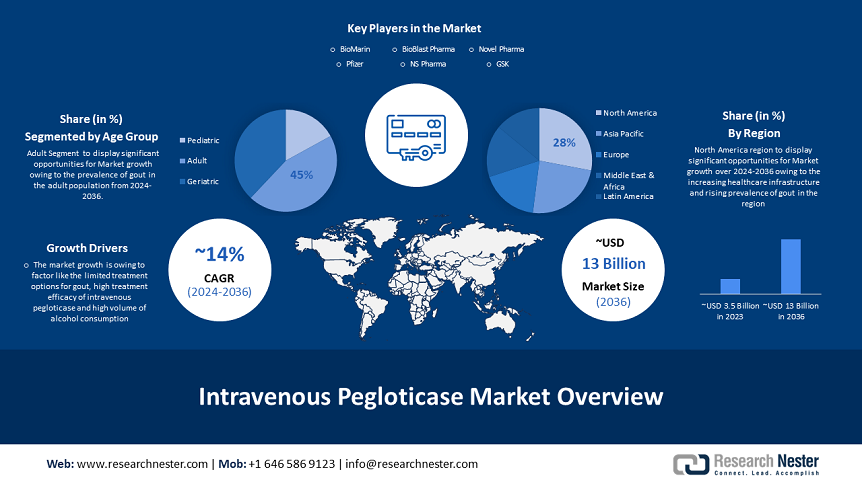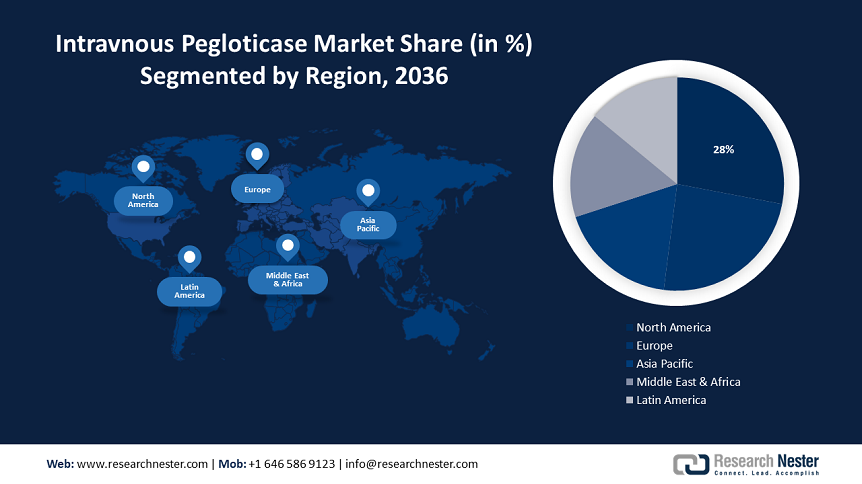
Intravenous Pegloticase Market size is poised to reach USD 13 Billion by the end of 2036, growing at a CAGR of 14% during the forecast period, i.e., 2024-2036. In the year 2023, the industry size of intravenous pegloticase was USD 3.5 Billion. The market is growing as a result of the rising prevalence of chronic and refractory gout among the global population. Intravenous pegloticase is used for the treatment of chronic and refractory gout in adults. It lowers uric acid levels and is typically prescribed when standard treatment has been ineffective. According to research, roughly 9.2 million people are afflicted with chronic and refractory gout, with men diagnosed more often than women.
In addition to these, the intravenous pegloticase market growth is owing to the aging global population. Gout typically occurs in men who are between the ages of forty and fifty years old. With people living longer lives than average, there is an increase in the number of geriatric people worldwide.

Growth Drivers
Challenges
|
Base Year |
2023 |
|
Forecast Year |
2024-2036 |
|
CAGR |
~14% |
|
Base Year Market Size (2023) |
~ USD 3.5 Billion |
|
Forecast Year Market Size (2036) |
~ USD 13 Billion |
|
Regional Scope |
|
Age Group (Pediatric, Adult, Geriatric)
In terms of age group, the adult segment is is anticipated to hold 45% share of the global intravenous pegloticase market by 2036. The segment growth can be attributed to the increasing presence of gout disease in the adult population. According to research, the global gout prevalent cases in individuals aged 15-39 years was 5.21 million in 2019 with the annual occurrence gradually increasing from 38.71 to 46 per 100,000 population from 1990 to 2019. The higher prevalence of gout in adults can be credited to the level of estrogen in their body and consumption of diet such as red meat and alcohol which are responsible for the regulation of uric acid that causes gout.
End Users (Hospital Pharmacies, Retail Pharmacies & Others)
The hospital pharmacies segment in the intravenous pegloticase market is estimated to gain a significant share of about 46% in the year 2036. The segment growth can be attributed to the high frequency of patients in the hospitals. As patients seek medical care and treatment from the hospital, the demand for pharmaceutical services within the healthcare faculties has surged as a result almost every hospital has its pharmacy. Hospital pharmacies play a crucial role in ensuring patients receive the medications they need promptly and safely during their stay.
Our in-depth analysis of the global market includes the following segments:
|
Age Group |
|
|
Indication |
|
|
End Users |
|
North American Market Forecast
The intravenous pegloticase market in North America is anticipated to hold the largest share of about ~28% by the end of 2036. The market growth in the region is also expected on account of the high prevalence of gout in the adult population. According to researchers, in 2018 there were approximately 13 million prevalent cases of gout were recorded in the United States. This number is expected to rise due to factors like unhealthy lifestyles and the aging population of this region. Additionally, increasing healthcare infrastructure is driving the expansion further in North America. As healthcare facilities like hospitals and clinics enhance their capabilities and accessibility more patients gain access to specialized treatments like intravenous pegloticase. This infrastructure growth in this region translates to improved patient care pathways, streamlined treatment delivery, and better integration of specialty services. Thus, the alignment between rising gout prevalence and the development of healthcare infrastructure is expected to spur the market growth of the intravenous pegloticase market in the North American region.
APAC Market Analysis
The Asia Pacific intravenous pegloticase market is estimated to be the second largest share of about ~22% by the end of 2036. The market’s expansion can be attributed majorly to the high product demand due to high growing aging population and increasing incidence of gout in the region. In 2019, there were 16.2 million cases of gout in China, were men and women accounting for 12 million and 4.1 million respectively. Furthermore, studies suggest that estimated gout case counts are high in Asia Pacific regions as there were 6 million cases in East Asia, 7 million cases in South Asia, and 0.6 million cases in Australasia. The increasing prevalence of gout in the region can be attributed to factors such as changes in lifestyle, dietary habits, and an aging population. As the incidence of gout rises there is a growing need for effective treatment like intravenous pegloticase. Thus, driving the intravenous pegloticase market growth of intravenous pegloticase in the region.


Author Credits: Radhika Pawar
Copyright © 2024 Research Nester. All Rights Reserved

FREE Sample Copy includes market overview, growth trends, statistical charts & tables, forecast estimates, and much more.
Have questions before ordering this report?